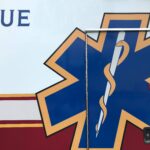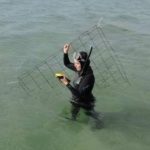INDIAN RIVER COUNTY – Hundreds of budding scientists flocked to Gifford Middle School early on a Saturday – trading in a lazy morning for the opportunity to win scholarships and be selected to move on to the state science fair.
Nearly 500 science fair projects were entered into this year’s Indian River County School District Regional Science Fair, an increase over recent years, according to one of the judges.
“They’ve done a great job,” said Judge Brian Mayo, who spent his morning in Gifford Middle’s gymnasium judging the Junior and Senior Division of the fair. This is his fourth year participating in the fair. Older student scientists crafted projects to study a host of scientific problems – from interstellar space travel to the effects of caffeine on the human heart.
The younger science enthusiasts in elementary schools studied the effect the force and angles on rubber bands’ travel and how best to shine pennies.
Emily Zeck and Taryn Simm, eighth graders at St. Edwards Middle School, tried their hands at catapults, studying the effect of the catapult’s length on the distance an object is hurled.
The girls are volleyball players and got the idea to test the catapult after realizing that volleyball players with longer arms could hit the ball farther.
Sure enough, their science fair project confirmed their suspicion. Zeck explained that for every centimeter the catapult’s arm was shortened, the flung object’s distance decreased by 12 centimeters.
The science fair project Sebastian River High School senior Damien Gilliams, Jr., originally planned didn’t work out, which left him trying to find something else to study.
“It was quite an evolution,” he said of his project, explaining he was going to work with gasoline and engines but decided it was too dangerous.
Instead, he chose to work with caffeine, trying to find a more economical and environmentally friendly way to extract the chemical compound.
Gilliams said coffee companies extract caffeine from products to make decaf and then sell that caffeine to other suppliers, such as energy drink manufacturers.
He tested two extraction methods to compare the cost, environmental impact and chemical yield.
Fellow Sebastian River High student, 10th grader Jeffrey Price, took his science fair project into outer space to determine if cosmic particles could be a potential source of propulsion for interstellar space travel.
The idea, he said, came from the work scientists are doing with the Large Hadron Collider, smashing particles and studying anti-matter.
Using magnetic fields, Price’s project supports the theory that such particles could indeed be used for space travel – and even more, could allow for travel near the speed of light.
Judge Mayo said what most impressed him about this year’s crop of scientists was their consistency in following scientific research procedures of stating the problem, formulating a way to test the problem, and then replicating the results to be sure they had consistent findings.
Of the projects he had seen about an hour into the judging, Mayo said the projects that could be applicable to daily life and the environment were the ones he was impressed with, including one scientist’s project that examined the lift forces on a house during a hurricane and environmental testing on the Indian River Lagoon.
Mayo added that he was encouraged by the number of entrants in the regional science fair this year because Indian River County isn’t well-known as a scientific community.
Awards will be handed out for the Elementary Division on Sunday, Jan. 31, at the Sebastian River High School Performing Arts Center beginning at 2 p.m.
The Secondary (Junior-Senior Division) Awards Ceremony will be held Thursday, Feb. 4, at the Vero Beach High School Performing Arts Center at 6 p.m.
***
Regional Science Fair Fast Facts
No. Elementary School Projects: 232No. Elementary Schools: 20No. Projects per School:-Most: 15 – Pelican Island Elementary-Avg.(mode): 14 – 10 schools each
No. Junior-Senior Division Categories: 15-Most Entries: 31 – Botany, Environmental Sciences-Least Entries: 3 – Computer Science, Mathematics-Avg. (median) Entries: 14
No. Junior-Senior Division Projects: 241No. Middle, High, Charter Schools: 13No. Projects per School:-Most: 64 – Gifford Middle School-2nd Most: 45 – Storm Grove Middle School-Avg. (mean): 18.5






